1.14: Country Rock, Southern Rock and Jazz Rock
- Page ID
- 168918
Country
Willie Nelson
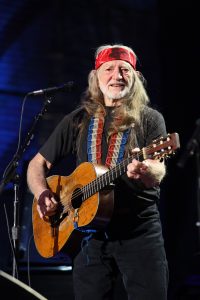
Willie Nelson – (born 1933) Singer/songwriter in country music. He is known for making his own brand of country music outside the confines of the conservative Nashville sound. Nashville was/is the hub of country music, hosting many recording studios, record labels, and venues associated with country. The music coming out of Nashville in the 1960s was conservative, utilizing similar sets of instruments, vocal timbres, song forms, etc. The labels generally would not allow experimentation such as the incorporation of rock and roll sounds.
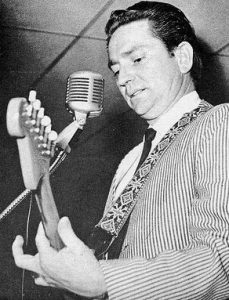
Nelson worked as a songwriter in Nashville in this conservative climate. His first hit song was “Crazy”, written in 1961. The song was recorded the following year by country star Patsy Cline, whose superb recording of the song reached No. 2 on the country charts. While he had a number of other country hits there through the 1960s, he retired from performing in 1972 due to frustration with the creative restrictions he felt from the Nashville community. He moved to Austin, Texas around the same time, and he found a thriving music scene and hippie movement there. This gave him the confidence to return to music, writing songs without restrictions. He soon returned with his new “outlaw” country sound on the album Shotgun Willie (1973). Outlaw country had broader appeal, reaching rock audiences and country audiences alike, and made Nelson a much more famous performer than he had been as a conservative Nashville country musician.
Outlaw country was less conservative lyrically, and more raw sonically (meaning a less polished production quality, grittier guitars) and featured rock elements such as rock oriented drums. In many songs, the musical elements will blend in a way that bridges the gap between rock and country. In the song “Whiskey River” (from Shotgun Willie), Nelson plays in two distinct styles in the two contrasting sections. In the A section, the rhythm is loose, bluesy and syncopated. The instruments improvise bluesy counter melodies, and the music is very dissimilar to traditional country. This all changes in the B section (starting at :51 in the recording in Listening Examples 14.1) when the band completely alters the rhythm and playing style, morphing into a very traditional country style. The bass begins playing in a two-beat style, and the drums go into a straight rhythm, with very little syncopation.
Nelson has continued recording and performing through to the present day. He is at the center of musical events such as Farm Aid which use music to help raise awareness and money for family farms struggling against factory farms. Nelson is now a major spokesman for many liberal causes, and he has a biodiesel company that makes fuel from vegetable oil.
Waylon Jennings
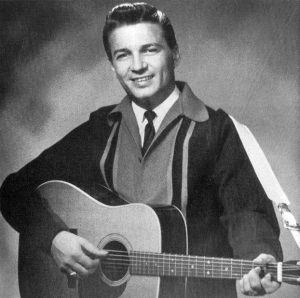
Waylon Jennings – (1937-2002) Was a country singer/songwriter important in the development of the music. He played bass in Buddy Holly’s band that he formed upon dissolving the Crickets. Jennings gave up his seat on the plane that killed Holly after losing a bet, a fact which haunted him his entire life.
Jennings was signed to RCA Victor in 1965 where he began releasing country albums. His sound is distinctive; his voice is very powerful, low, and rough. This deep vocal sound was, along with that of George Jones, very influential on the singers that came after them.
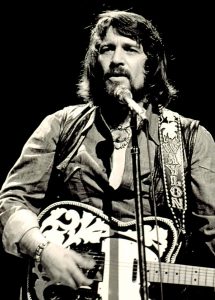
Dissatisfied with the restrictions of Nashville country, he followed the example of Willie Nelson and began exerting more of his own creative control on his music, helping to develop the “Outlaw Country” sound. This, like Willie Nelson, improved Jennings’ success; he had 11 No. 1 albums and 16 No. 1 singles in his career. His success was hampered by drug addictions which he was able to beat in the 1980’s. The effects on his health were permanent though, and his live performances became very rare in the last years of his life.
Gram Parsons
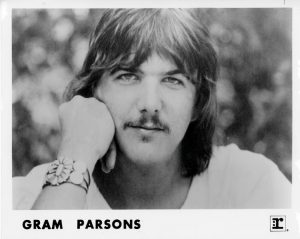
Gram Parsons – (1946-1973) Was a singer/songwriter that was instrumental in the development of country-rock. He played with the International Submarine Band before joining the Byrds in 1968. The Byrds were primarily a folk-rock group but Parsons brought in country influences and their album Sweetheart of the Rodeo is a synthesis of country and rock. He left the Byrds the same year, refusing to go on tour with the band in South Africa due to its policy of racial segregation. He and former Byrds bass player Chris Hillman formed The Flying Burrito Brothers. This group was a more successful synthesis of country and rock using pedal steel guitar, rock beats, and Everly Brothers style harmonies. The vocal style lacked the nasal quality and accent of singers like Hank Williams. Parsons left the group in 1970 to pursue a solo career, often playing with Emmylou Harris. He died in 1973 at age 26.
Listening Examples 14.1
Willie Nelson:“Crazy” was written by Willie Nelson and performed by Patsy Cline (1962). “Whisky River” features a combination of rock and country elements. While pedal steel guitar sounds are heard and Nelson’s voice is characteristically country, rock drum beats are used and bluesy guitar melodies are featured.
Waylon Jennings: Notice the mixture of Country and Rock elements in “Lonesome, On’ry and Mean”. The drums are rock oriented, while the bass is still identifiable as “two-beat bass” and pedal steel guitar (a traditional country instrument) is featured alongside bluesy harmonica.
The Byrds:“Hickory Wind” was written by Gram Parsons. While many country and even bluegrass elements are present such as pedal-steel guitar, banjo, fiddle, and occasional two-beat bass, Parsons’ vocal quality is still very much folk/rock oriented. Listen as the Byrds play two Bob Dylan songs “You Ain’t goin Nowhere” and “This Wheels on Fire” live.
Southern Rock
Allman Brothers Band
The Allman Brothers Band was one of the first groups known as southern rock. The band consisted of two lead guitarists, Duane Allman and Dickey Betts creating a very unique sound. They were fronted by keyboardist and singer Gregg Allman, and also had two drummers. The sound combined rock, blues, jazz, and country into a unique fusion of styles.
The two lead guitars would often harmonize with each other which gave them their signature sound. Harmonizing in this context is the combination of two or more musical lines moving in parallel with each other but using different notes from each other to add depth to the melody. The group emphasized improvisation which would often include “Trading Twos” where the lead guitars would alternate improvising back and forth much like a call and response.
Inspired by players like Elmore James, Duane Allman brought bottleneck slide on electric guitar to a new level of dexterity and musicality. His slide lines were rich and sustaining due to the overdriven amp sound, and had a vocal quality and dexterity beyond most previous slide guitarists. In 1971, Duane Allman died in a motorcycle accident. The group continued on with Dickey Betts and Greg Allman leading. They had hits including “Ramblin’ Man” and the instrumental “Jessica”, but personal problems led to a series of breakups and reformations throughout the late 1970s and 1980s. While never achieving the same level of commercial success they had in the 1970s, the group continued as one of the most popular live acts in the U.S. (even after founder Dickey Betts was fired in 2000) until Gregg Allman’s health forced him to quit performing in 2016. He passed away in May of 2017.
Listening Examples 14.2
Allman Brothers Band: First, listen to “Statesboro Blues” feat. Duane Allman on slide guitar (featuring animation and background on the song’s origins). The sound of Duane Allman’s guitar is a showcase of his mastery of the slide. Notice how fluid the lines sound, much more akin to a human voice. Compare this sound to that of Elmore James and Robert Johnson before that to hear the way slide guitar has evolved. Also, Gregg Allman displays his lead vocal skills which are influenced greatly by blues and gospel music. Try to identify the song form.
“Ramblin Man” was one of the Allman Brothers biggest hits, featuring two-guitar harmonized lines throughout as well as memorable lyrics and vocal line. Released in 1973, the song reached No. 2 on the Billboard pop charts and remains the group’s only top 10 single. Also, guitarist Dickey Betts takes lead vocals on the song. Notice that the quality of his voice is much different from that of Gregg Allman’s, being influenced much more by country music rather than gospel or blues.
Finally, listen as I play electric guitar with a slide. Notice that the sound is overdriven but sweet, somewhat evocative of the human voice. To achieve a warmer sound like this, I roll the “Tone Knob” down on the guitar, cutting out some of the harsher high frequencies. Also, I demonstrate the ability to play notes beyond the fingerboard of the guitar. It’s quite difficult to control the pitches that high up on the guitar, so don’t expect anything particularly pretty!
Other Southern Rock Groups
Southern rock continued to grow with a variety of groups. The Charlie Daniels Band worked with the style the Allman Brothers Band had pioneered. Charlie Daniels is a multi-instrumentalist who plays fiddle, electric guitar, and slide guitar. His songs include “The South’s Gonna Do It (Again)” and “The Devil Went Down to Georgia” (below).
Lynyrd Skynyrd was a southern rock group that was immensely popular with the general rock audience. Boasting three lead guitars, they were influenced by the Allman Brothers with regards to lead guitar harmonies and included long jams on songs like “Free Bird”. Their recording “Sweet Home Alabama” reached No. 8 on the pop charts. This song includes a variety of characteristics from other styles, including a female vocal group responding to singer Ronnie Van Zant’s vocals in a gospel style, Allman Brothers style multiple-lead-guitars, and honkey tonk style piano.
In 1977, a plane crash killed singer Ronnie Van Zant, guitarist Steve Gaines, and backing singer Cassie Gaines. A new version of the group formed with Van Zant’s brother on vocals, and continue to tour today.
Listening Examples 14.3
Charlie Daniels: “Devil Went Down to Georgia”
Lynrd Skynrd: “Free Bird”
Jazz Rock and Fusion
Rock musicians had been incorporating jazz into the music from the beginning in a variety of ways, and since both genres are American, they share common ancestors. Blues was important to the development of both jazz and rock, though jazz began long before rock and therefore emerged much different.
Instruments associated with jazz such as the saxophone had long been a part of rock and rhythm and blues, and often played jazz-styled improvisations. Two distinct approaches to the blend of jazz and rock emerged in the 1960s and 1970s. For the purposes of this course, we’ll designate them as Jazz-Rock and Fusion.
Jazz-Rock will be considered a rock-based style. It almost always uses vocals as the primary focus, essential to rock music. It was more rock-oriented with very few of the complex chord changes of jazz, and was more often played by rock musicians experimenting with elements of jazz. Jazz-Rock often combines the horn section sound of swing jazz with rock beats and rock rhythm sections, giving it a strong relationship to rock music.
Fusion will be considered a jazz-based style, not a rock style. It uses rock instrumentation and some rock beats or rhythmic patterns. Primarily instrumental music, like most jazz, fusion rarely featured vocals and in those cases they weren’t given any more prominence than the instruments. This style was mostly musicians from jazz backgrounds experimenting with elements of rock music.
Jazz-Rock
Electric Flag
Electric Flag formed in 1967 in San Francisco and was led by blues guitarist Mike Bloomfield, who formerly played with the Paul Butterfield Blues Band. Bloomfield, who was born in Chicago, was an important part of the blues revival of the 1960s, bringing an authentic blues guitar sound to wider audiences of pop music.Electric Flag used the standard rock rhythm section plus a big band style horn section including trumpet, tenor sax, and baritone sax. Vocals were at the forefront of the music, and blues was the primary influence on the music. The group only played for a year and a half but served as a template for the jazz-rock groups that would follow.
Chicago
Chicago formed in 1967 (in Chicago) by guitarist/singer Terry Kath and woodwind player Walter Parazaider. Like other jazz-rock groups, Chicago consisted of a horn section of trumpet, trombone, and sax and a rock rhythm section of guitar, bass, keyboard, and drums.
Chicago was unique because most of the players were singers as well, and group vocals were featured. Their early style featured more jazz-styled improvisations by the individual soloists and extended instrumental arrangements. Later on their style would become more pop-oriented in order to reach a larger audience. Still going, they released their latest album album in July 2014 and continue to tour today.
Blood Sweat and Tears
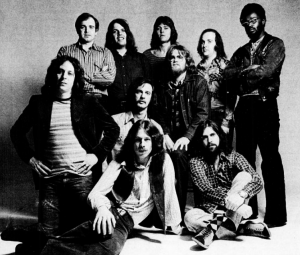
Blood, Sweat and Tears was formed by singer/keyboard player Al Kooper. Though the personnel of the group changed often, their brass-driven sound was always maintained. The group merged pop, rock and rhythm and blues styles with jazz-styled horn arrangements which epitomize the ‘jazz-rock’ sound.
Kooper left due to creative differences and singer David Clayton-Thomas replaced him for the recording of their second album (self titled). Blood, Sweat and Tears subsequently won a grammy and has gone quadruple platinum. This album displayed a much more commercial-oriented but still retained many of the same jazz elements. “Spinning Wheel” (below), written by their new singer David Clayton-Thomas, is their most popular song. It uses a repeating cycle of four chords in the A section that can be seen as resembling a spinning wheel.
Steely Dan
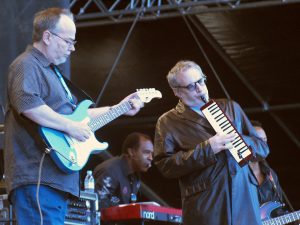
Steely Dan was formed by pianist Donald Fagen and guitarist Walter Becker. Originally a foursome, the band was reduced to a duo with Fagen and Becker by 1974 due to their dislike for touring. Because they didn’t bother touring, the duo concentrated on recording and writing, all the while bringing in whatever musicians they felt would best add to the track.
Both were jazz lovers and incorporated elements of jazz into their pop/rock songwriting including horns, jazz-styled chord progressions, and guest musicians with extensive jazz backgrounds. They covered jazz standards such as Duke Ellington’s “East St. Louis Toodle-oo”, copying the 1927 recording precisely while adding rock elements such as electric guitar and pedal steel guitar where horns had been originally.
They had many successful albums and songs including “Rikki Don’t Lose That Number” from Pretzel Logic. Other albums include The Royal Scamand Aja. By the 1980s, Fagen and Becker pursued solo careers in the 1980s but reunited in the 1990s and 2000s.
Listening Examples 14.4
Electric Flag: “Drinkin’ Wine” Live at Monterey Pop Festival
Chicago:
Blood Sweat and Tears: I play the chord cycle from “Spinning Wheel” a number of times to demonstrate the cyclical sound inherent in the progression.
Steely Dan:“Rikki Don’t Lose That Number” features verse-chorus form and many chord changes, giving it a sense of complexity similar to jazz. I play the chords from the verse and the chorus of “Rikki Don’t Lose That Number” in isolation to give you a better feel for the complexity of the song’s structure.
Fusion
Miles Davis
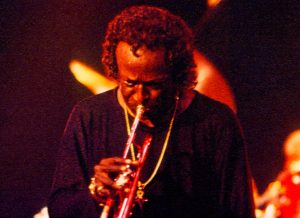
Miles Davis – (1926-1991) was one of the early pioneers of what became known as fusion jazz. Davis was a revolutionary jazz musician who began playing professionally in the 1940s. Always on the cutting edge of jazz, Davis began incorporating elements of rock into his music in the late 1960s. The rock elements he began adding were 1) Evenly subdivided rock drum beats; 2) short, repetitive bass lines; 3) rock instruments like electric guitar, electric piano, and electric bass.
On the albums In a Silent Way and Bitches Brew Davis used rock drum patterns, electric pianos, and an electric guitar. The music, however, is far from resembling the songs heard in rock music. Rather, structured improvisation is the primary musical component. A prime example is “Miles Runs the Voodoo Down” from Bitches Brew (1969), which features a drum beat with elements of rock and funk, while the instruments improvise extensively over top. An 11-minute instrumental, this music is not something we would consider radio-friendly. Yet the embracing of rock elements expanded Davis’ reach to younger listeners.
In live performance, Davis used effects similar to Jimi Hendrix such as wah-wah on his trumpet and began incorporating elements of funk music like that of James Brown and Sly and the Family Stone into his music.
John McLaughlin & Mahavishnu Orchestra
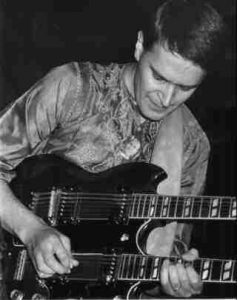
The Mahavishnu Orchestra played a very different version of fusion music from Miles Davis. There were strictly composed sections of music as well as purely improvised sections. All the players were instrumental virtuosos, playing complex lines extremely fast.
Led by composer/jazz guitarist John McLaughlin (who played with Miles Davis on his fusion albums), the group included violin, keyboard, electric bass, and drums. The group emphasized instrumental virtuosity and overwhelming flurries of notes and rhythms that excited audiences alongside unusual harmonies and dissonance, rock style drum beats, and heavily distorted guitars. The group lasted from 1971-73 at which point McLaughlin reformed with an all new group that included a string quartet and occasional vocals.
Weather Report
Weather Report was formed by Miles Davis alumni keyboardist Joseph Zawinul and saxophonist Wayne Shorter. Their brand of fusion used funk styled beats, a rock rhythm section with saxophone and an additional percussionist who added a Latin touch, complex compositions, and improvisation. Zawinul made use of the synthesizer which became a signature part of Weather Report’s sound. Virtuoso bass player Jaco Pastorius joined the group in 1976 and played bass at a technical level very few others had attained at that point. Though they went through many personnel changes, the group lasted from 1970-1986 with Zawinul and Shorter always remaining as co-leaders.
Allan Holdsworth
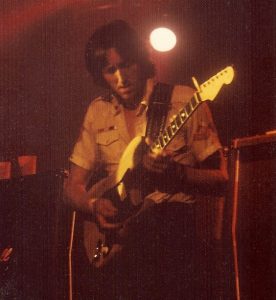
Allan Holdsworth (1946-2017) was an English-American guitarist credited with both expanding the possibilities of what the guitar can do and with bringing jazz to a wider audience. Often described as one of the most individual and unique guitarists in history, his playing is characterized by unorthodox, complex chords and a smooth, saxophone-like melodic technique executed extremely fast. In fact, Holdsworth has mentioned that he would have preferred to play a horn instrument instead of guitar, but his family couldn’t afford one so he chose guitar instead. His music includes a great deal of improvisation, and he is not afraid of free improvisation in which standard scales and chord changes are dropped in favor of a freely melodic, dissonant sound.
Holdsworth’s use of new technology in the 1980s such as the “SynthAxe” was unprecedented. The SynthAxe is a completely electronic synthesizer meant to respond to guitar player’s technique while having the same advantages as keyboard synthesizers.
Listening Examples 14.5
Miles Davis: Notice the funk-rock beats that emphasize the back beats rather than the swinging, uneven beat subdivisions so common in jazz in “Miles Runs the Voodoo Down”. Also, notice the minimal nature of all the instruments including sparse guitar and electric piano chords, repetitive bass lines, and sparse soloing (with use of space) from Davis on trumpet. Now, listen to the live version with some modifications to the groove.
Mahavishnu Orchestra:This video includes excerpts from the Mahavishnu Orchestra’s concert live at Paramount Theater in Seattle 1973. The first 2:20 features a good example of McLaughlin’s fusion of jazz and rock. “The Noonward Race” (Music starts around 1:15).
Weather Report: “Black Market”
Allan Holdsworth: Listen starting at 26:07 to “Letters of Marque” live in Tokyo. “Looking Glass” on the Synthaxe guitar synthesizer.
Finally, watch this short video I made about John McLaughlin and Allan Holdsworth on fusion guitar.


